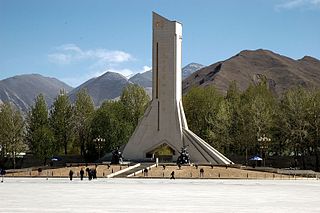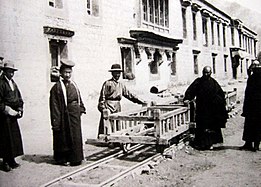
The Tibet Autonomous Region or Xizang Autonomous Region, often shortened to Tibet or Xizang, is a province-level autonomous region of the People's Republic of China in Southwest China. It was overlayed on the traditional Tibetan regions of Ü-Tsang and Kham.
Free Tibet (FT) is a non-profit, non-governmental organisation, founded in 1987 and based in London, England. According to their mission statement, Free Tibet advocates for "a free Tibet in which Tibetans are able to determine their own future and the human rights of all are respected."

Takna Jigme Sangpo was the longest-serving political prisoner of Tibetan ethnicity, having spent 37 years in a prison near Lhasa.

Ani Pachen was a Tibetan freedom fighter and activist.
The GuChuSum Political Prisoners Movement of Tibet is an organization of Tibetan exiles. Established on September 27, 1991, by self-designated former political prisoners, the words "Gu Chu Sum" stand for the numbers 9, 10 and 3, which mark three months in modern Tibetan history—September 1987, October 1987, and March 1988—, when major unrest were crushed in Lhasa, the capital of Tibet. It is one of four major NGOs of the Tibet-in-exile community. All 256 members of GuChuSum are former political prisoners.

Lhalu Tsewang Dorje commonly known as Lhalu, Lhalu Se, or Lhalu Shape, was a Tibetan aristocrat and politician who held a variety of positions in various Tibetan governments before and after 1951.

Ngawang Sangdrol is a former political prisoner, imprisoned at the age of 13 by the Government of the People's Republic of China, for peacefully demonstrating against the Chinese occupation of Tibet in 1992. She was at first held for eight months without trial, before being sentenced to a three-year prison term. Her sentence was extended repeatedly for continued protest in prison, which included recording a tape of freedom songs with 13 other nuns from Drapchi Prison that was smuggled out of Tibet.
Phuntsog Nyidron is a Tibetan Buddhist nun and a former high-profile prisoner in Tibet. In 1989, she and eight other nuns traveled from her hometown to the provincial capital of Lhasa when it was convulsed by Tibetan independence protests and riots, and handed out leaflets and shouted anti-Chinese slogans. She was tried and imprisoned for the charge of counterrevolutionary propaganda and incitement and imprisoned at the Drapchi Prison that same year. During her incarceration, she produced and smuggled out tapes of her and other prisoners' political songs, engaged in hunger strikes, and made publicized allegations of mistreatment. One of the better-known Tibetan prisoners outside Tibet, she was the subject of a release campaign by several United States Congress parliamentarians and governmental groups. Because of their efforts, and Chinese wishes to improve Sino-American relations, her sentence was reduced and commuted in 2004. She lives in Switzerland since 2006.
The 1987–1989 Tibetan unrest was a series of protests and demonstrations that called for Tibetan independence. These protests took place between September 1987 and March 1989 in the Tibet Autonomous Region, in the Tibetan regions of Sichuan, and Qinghai, as well as the Tibetan prefectures in Yunnan and Gansu. Protests began shortly after the Dalai Lama, the religious and temporal leader of Tibet exiled in India since the 1959 Tibetan unrest, proposed a Five Point Peace Plan regarding the “status of Tibet” on September 21, 1987, which was subsequently rejected by the Chinese government. The Plan advocated for greater respect and autonomy of the Tibetan people, and claimed that “Tibet was a fully independent state when the People’s Liberation Army invaded the country in 1949-50.” China rejected the idea of Tibetans as an invaded people, stating that “Tibet is an inalienable part of Chinese territory” and has been for hundreds of years. The Tibetan sovereignty debate is longstanding, and the Tibetan assertion that they are a separate and unique people invaded by China has become a central argument for their independence.
thumb|Passang Lhamo 2017Passang Lhamo is a Tibetan nun, activist, and singer.
Wangdu is a former Tibetan monk who became an HIV/AIDS activist at the age of 41. He was sentenced to life imprisonment in 2008 for "endangering state security", and in 2012 he was in hospital.
Human rights in Tibet is a contentious issue. Even though the United States advocates the human rights of the Tibetan people and even though it once provided funds to the Dalai Lama's independence movement, the United States does not participate in the Tibetan sovereignty debate and as a result, it does not recognize Tibet's right to exist as a country. Reported abuses of human rights in Tibet include restricted freedom of religion, belief, and association; arbitrary arrest; maltreatment in custody, including torture; and forced abortion and sterilization. The status of religion, mainly as it relates to figures who are both religious and political, such as the exile of the 14th Dalai Lama, is a regular object of criticism. Additionally, freedom of the press in China is absent, with Tibet's media tightly controlled by the Chinese leadership, making it difficult to accurately determine the scope of human rights abuses.
Shanghai Municipal Qingpu Prison is in Qingpu District on the outskirts of Shanghai, China. Supervised under Shanghai Municipal Prison Administration, the 300-mu prison officially opened on 24 December 1994, guarded by 300 police officers.
The Tibetan Centre for Human Rights and Democracy (TCHRD) is a Tibetan non-governmental nonprofit human rights organization.

Protests and uprisings in Tibet against the government of the People's Republic of China have occurred since 1950, and include the 1959 uprising, the 2008 uprising, and the subsequent self-immolation protests.

Drapchi is a 2013 Tibetan-language Film directed by Arvind Iyer and stars acclaimed Tibetan singer Namgyal Lhamo in the lead role as Yiga Gyalnang. The film is a musical drama set against the backdrop of Tibet and Nepal and based on a true story. Drapchi has screened at the Manneim-Heidelberg, Cairo International, Warsaw International, Kerala International and Rome Independent Film Festival.

The Monument to the Peaceful Liberation of Tibet stands in the southern part of the Potala square in Lhasa, Tibet Autonomous Region just outside the protective zone and buffer zone of the World Heritage Site. It celebrates what the People's Republic of China calls the Peaceful Liberation of Tibet by the People's Liberation Army, or what the exiled Tibetan government calls the invasion and annexation of Tibet. The foundation stone was laid on July 18, 2001 by Hu Jintao, China's vice-president at the time. The monument was unveiled on May 22, 2002.

Jigme Gyatso is a Tibetan activist of the Tibetan Independence Organisation who, in 1996, was sentenced to 15 years in prison on charges of "leading a counter-revolutionary organisation" and "inciting splittism". Two more years were added to his sentence in 2004 when he protested in jail. Several international human rights groups have protested or campaigned on his behalf, and Amnesty International has designated him a prisoner of conscience.

Chen Quanguo is a retiring Chinese politician and the current deputy head of the CCP Central Rural Work Leading Group. Between 2017 and 2022, he was a member of the 19th Politburo of the Chinese Communist Party and was previously the Chinese Communist Party Committee Secretary of Tibet Autonomous Region from 2011 to 2016 and of the Xinjiang Uyghur Autonomous Region from 2016 to 2021, making him the only person to serve as the Party Secretary for both autonomous regions. Chen was also Political Commissar of the Xinjiang Production and Construction Corps concurrently with his position as Xinjiang Party Secretary.
Lanzhou Prison is a high-security prison in Lanzhou. The prison grounds include several workshops where prisoners work.















